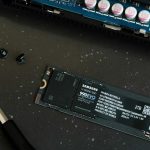Unlock the full power of your NVMe SSD with a few simple tweaks. Optimizing settings can boost speed, enhance system performance, and extend your drive’s lifespan. Don’t let valuable hardware go underutilized—maximize what your SSD can truly offer.
Update the Drivers and NVMe Firmware
Outdated drivers can quietly throttle your NVMe SSD’s performance. While Windows may install generic drivers by default, it often prioritizes compatibility over speed. To unlock full potential, install the latest storage controller drivers and firmware from your SSD manufacturer.
Brands like Samsung, Western Digital, and Crucial release optimized updates that enhance read/write speeds, minimize latency, and address bugs. Check for updates in Device Manager, or use manufacturer tools like Samsung Magician or Crucial Storage Executive for automatic management.
Driver and firmware updates won’t double your speed, but they’re essential for consistent, high-level NVMe performance.
Read More: Common SSD Mistakes That Quietly Cut Its Lifespan Short
Make Sure Your NVMe Is Running in the Correct PCIe Mode
Your NVMe SSD won’t reach full speed if it’s running in the wrong PCIe mode. For example, a PCIe 4.0 drive operating at 3.0 speeds will see a major performance drop, often without warning.
Check your motherboard’s NVMe slot compatibility to confirm it supports your drive’s generation. Use CrystalDiskInfo to verify the “Transfer Mode.” If a Gen4 drive shows “PCIe 3.0 x4,” you’re not getting peak performance. Causes include outdated BIOS, incorrect slot usage, or improper BIOS settings.
Don’t confuse CrystalDiskInfo (for drive information) with CrystalDiskMark (for speed tests). Together, they provide a complete view of your NVMe drive’s health and performance.
Enable TRIM to Keep Your NVMe Running Smoothly
TRIM is a critical yet often overlooked feature that keeps your NVMe SSD running at peak performance. Without it, your drive slows down over time—even after deleting files—because unused data blocks aren’t properly cleared.
Unlike HDDs, NVMe drives can’t overwrite data directly. They must erase storage cells first, creating delays. TRIM fixes this by identifying unused blocks so the SSD can clean them in the background, reducing write latency and improving efficiency.
Enabling TRIM also helps extend your drive’s lifespan. Windows 10 and 11 usually have it on by default, but it’s smart to double-check:
- Open Command Prompt as admin (search “cmd” > right-click > Run as administrator).
- Type: fsutil behavior query DisableDeleteNotify
- If the result is = 0, TRIM is active.
- If it’s = 1, enable it by typing: fsutil behavior set DisableDeleteNotify 0
Windows runs TRIM automatically, but heavy file transfers or disk-intensive apps may benefit from more frequent cleanups.
Adjust These Windows Settings for Maximum Speed
Windows includes several settings that can affect your NVMe SSD’s speed and efficiency. While these tweaks won’t deliver massive gains, they’re still worth applying to ensure your drive runs at its best.
Start by disabling the Windows Search Indexer, especially if your drive is used mainly for gaming or apps. This service constantly writes data, impacting both performance and SSD lifespan.
Next, switch your power plan from “Balanced” to “High Performance.” The default setting can throttle performance to save energy, unnecessary on desktops or performance-focused setups.
Also, review virtual memory settings (Pagefile.sys). Even with 16GB+ RAM, Windows writes temporary data to your SSD. Move the page file to a secondary drive or manually size it to reduce wear on your NVMe.
Advanced users can explore Windows Registry tweaks for further gains. Adjusting storage timeouts or command queuing may improve responsiveness. Just remember to back up your registry before making any changes.
Monitor NVMe Temperatures to Prevent Throttling
NVMe SSDs run much hotter than SATA drives, and excessive heat directly impacts performance and lifespan. Once temperatures hit around 70°C (158°F), thermal throttling kicks in, slowing speeds to prevent damage and defeating the purpose of high-speed storage.
During heavy file transfers, drives like the Apacer PCIe 4.0 NVMe often spike in temperature and throttle automatically without warning. Use tools like HWiNFO64 or CrystalDiskInfo to monitor temps in real time and catch issues early.
Solution: Add an M.2 NVMe heatsink—a simple, affordable upgrade that improves heat dissipation. Many high-performance drives include one, but if you’re on a laptop, enhance cooling with better airflow or a quality cooling pad.
Run These Benchmarks to Verify Your Improvements
After optimizing your NVMe SSD, validate the results with CrystalDiskMark. This free tool benchmarks sequential and random read/write speeds—key indicators of real-world performance.
Start by running a test before any tweaks to create a baseline. Then, retest after each major change to measure improvements. Focus on two metrics:
- SEQ1M shows sequential speed with large files, ideal for tasks like video transfers.
- RND4K tests small, random data access, which affects boot times and app launches.
Pay attention to Q (Queue Depth) and T (Thread Count) values. Q1T1 simulates everyday use, while higher values reflect heavier workloads like gaming or content creation.
Tuning your NVMe SSD goes beyond hitting high benchmark scores—it ensures you’re getting the performance you paid for. With the right tweaks, your system becomes faster, more responsive, and efficient. Every day tasks feel smoother, file transfers speed up, and your drive may even last longer.
Frequently Asked Questions
How can I improve my NVMe SSD performance?
You can boost performance by updating firmware and drivers, enabling TRIM, using the right PCIe slot, improving cooling, adjusting Windows settings, and benchmarking changes with tools like CrystalDiskMark.
What BIOS settings affect NVMe SSD speed?
Key BIOS settings include enabling PCIe Gen4 (if supported), setting the correct M.2 slot, and enabling AHCI or NVMe mode. Make sure to update the BIOS to the latest version for full compatibility.
Does TRIM really make a difference for NVMe SSDs?
Yes. TRIM helps maintain write performance and extends SSD lifespan by clearing unused data blocks, allowing faster and cleaner data writes.
Is a heatsink necessary for NVMe SSDs?
While not always required, a heatsink can prevent thermal throttling, especially under heavy load. This ensures consistent read/write speeds and protects your drive’s health.
Should I disable Windows indexing on my SSD?
Yes, especially for gaming or performance-focused systems. Disabling indexing reduces unnecessary background writes, preserving both speed and SSD lifespan.
How do I know if my NVMe SSD is running at full speed?
Use CrystalDiskInfo to check interface speed and CrystalDiskMark to test performance. Make sure your SSD is installed in the correct slot and operating at its intended PCIe generation (e.g., Gen4 x4).
Conclusion
Maximizing NVMe SSD performance doesn’t require expert-level skills—just the right settings and smart maintenance. From updating drivers and enabling TRIM to improving cooling and verifying PCIe modes, each step contributes to faster speeds, smoother workflows, and longer drive life. Apply these simple tweaks, and you’ll unlock the full potential of your SSD—whether for gaming, productivity, or everyday computing. Regular checks and updates ensure your system stays optimized and future-proof.











